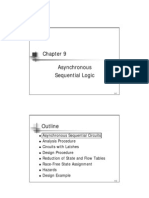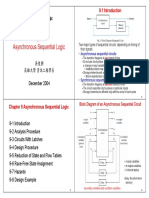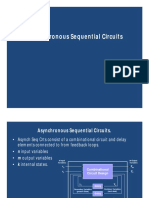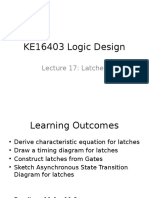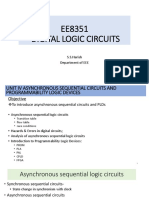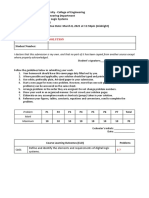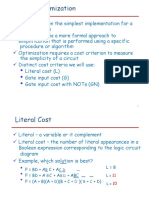0% found this document useful (0 votes)
98 views31 pagesAsynchronous Sequential Logic Guide
This document discusses asynchronous sequential circuits. It outlines analysis and design procedures for asynchronous sequential circuits using latches. Key points include:
- Asynchronous sequential circuits have internal states that can change at any time in response to input changes, without a clock signal.
- Analysis procedures involve constructing transition tables from circuit diagrams with latches to identify stable states where the current and next states are equal.
- Design procedures aim to avoid "race conditions" where state assignments could lead to unpredictable behavior, through techniques like race-free state assignments that direct circuits through unique intermediate states.
- Latches like SR latches are commonly used as memory elements in asynchronous circuit designs to provide an orderly structure with memory elements clearly visible
Uploaded by
kirthicaCopyright
© © All Rights Reserved
We take content rights seriously. If you suspect this is your content, claim it here.
Available Formats
Download as DOCX, PDF, TXT or read online on Scribd
0% found this document useful (0 votes)
98 views31 pagesAsynchronous Sequential Logic Guide
This document discusses asynchronous sequential circuits. It outlines analysis and design procedures for asynchronous sequential circuits using latches. Key points include:
- Asynchronous sequential circuits have internal states that can change at any time in response to input changes, without a clock signal.
- Analysis procedures involve constructing transition tables from circuit diagrams with latches to identify stable states where the current and next states are equal.
- Design procedures aim to avoid "race conditions" where state assignments could lead to unpredictable behavior, through techniques like race-free state assignments that direct circuits through unique intermediate states.
- Latches like SR latches are commonly used as memory elements in asynchronous circuit designs to provide an orderly structure with memory elements clearly visible
Uploaded by
kirthicaCopyright
© © All Rights Reserved
We take content rights seriously. If you suspect this is your content, claim it here.
Available Formats
Download as DOCX, PDF, TXT or read online on Scribd
/ 31
